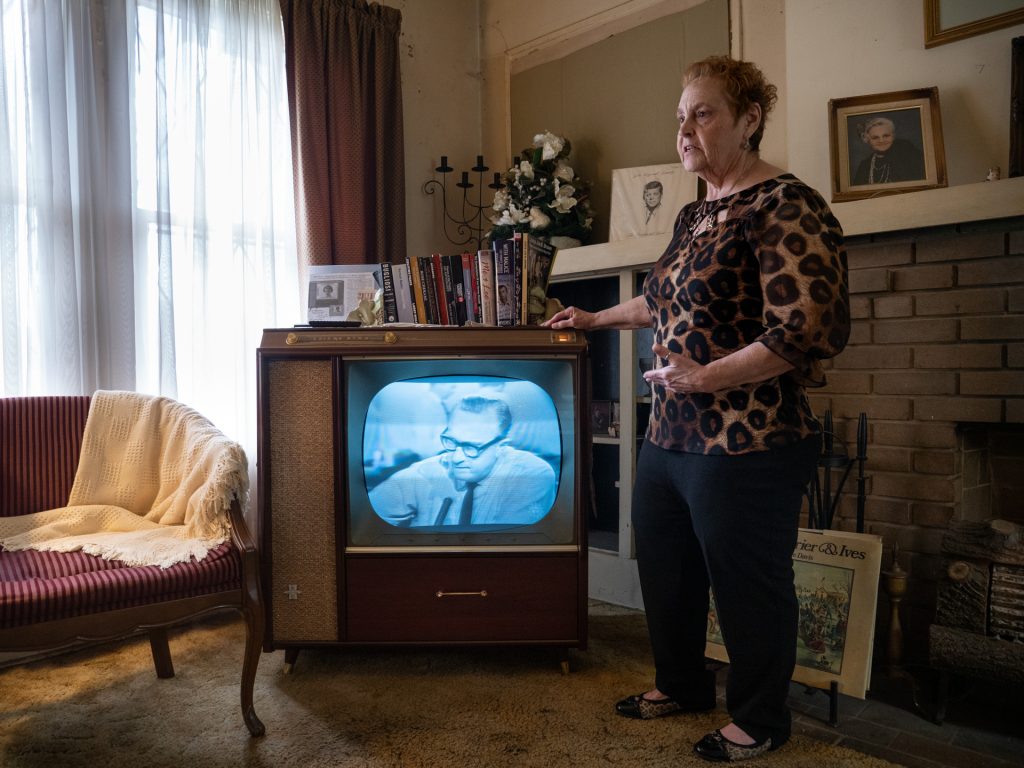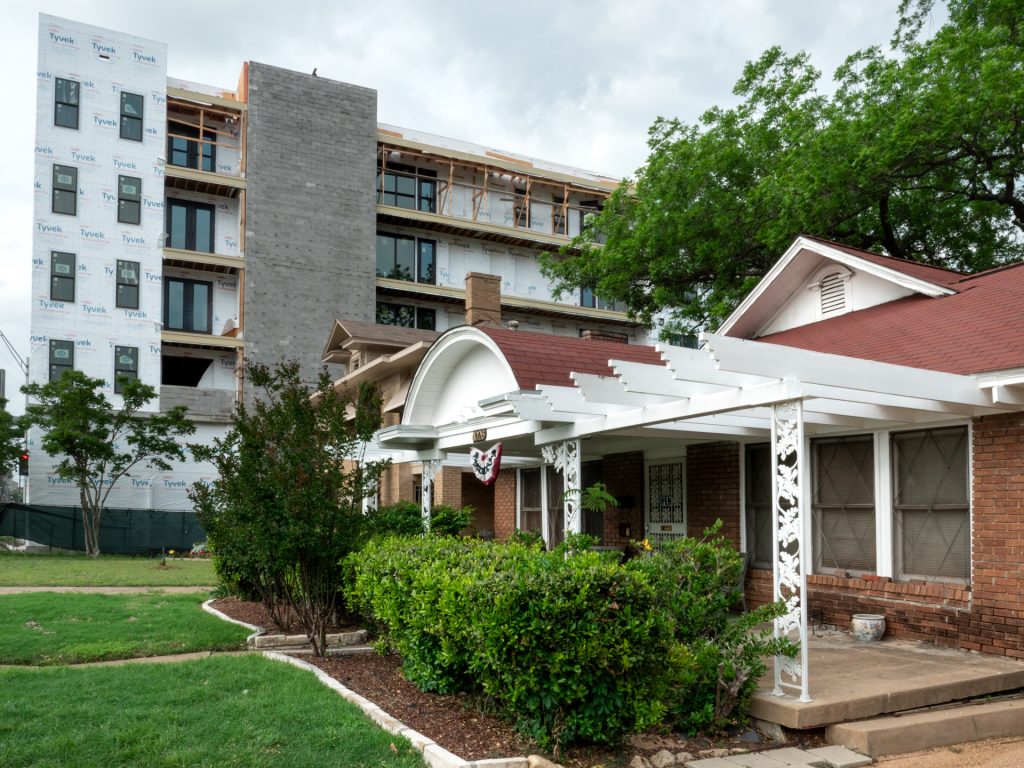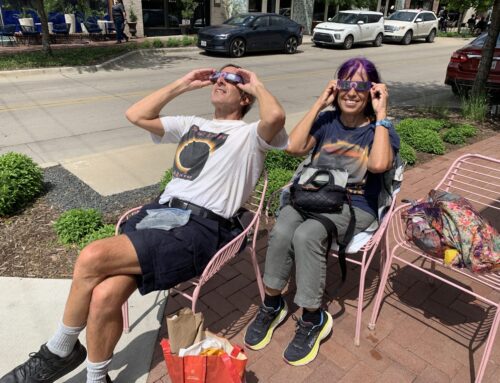As new construction surrounds it, one Lake Cliff residence is a time-capsule glimpse into the man who shot JFK
In the aftermath of John F. Kennedy’s assassination and the arrest and killing of Lee Harvey Oswald, reporters descended on Gladys Johnson’s Oak Cliff boarding house, where — under the name O.H. Lee — Oswald rented one of her 18 rooms.
A mourning public was desperate to learn more about the man suspected of killing the president. Maybe the inhabitants of 1026 N. Beckley had answers?
In a TV news package filmed in the days following the assassination, Johnson’s housekeeper Earlene Roberts stands in the living room answering reporters’ questions about Nov. 22. One hand resting on a large box TV set, Roberts says she saw Oswald come in about 1 p.m. the day of the shooting and walk briskly to his bedroom. He came out wearing an Eisenhower-style jacket and left in a hurry.
The house is still in place today, looking much as it did then. The front porch, paint chipped and crumbling in places, holds a broken bench and some chairs on which few would risk sitting. The screen door through which Oswald came and went hangs on shaky hinges. The only indication of the place’s historical significance is a small yard sign that reads “Oswald Rooming House Museum.”
The owner, Patricia Hall — Johnson’s granddaughter who was 11 in 1963 — began offering tours about nine years ago. She says people were always coming by asking to see the place anyway, and it seemed a good way to make a little extra money.
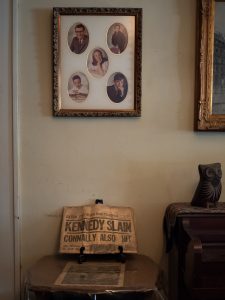 Visitors can see the living area — set up just as it was in that interview with Roberts, same TV, same sofa and “the phone where Oswald talked to (his wife) Marina in Russian,” Hall says. They can also see Oswald’s room, adjacent to the great room, complete with the frame of the bed where Oswald slept (Hall has since changed the mattress, because not doing so “would be creepy,” she says) and the wardrobe that held his light gray jacket (inside she hung a replica, so tourists can see what it looked like).
Visitors can see the living area — set up just as it was in that interview with Roberts, same TV, same sofa and “the phone where Oswald talked to (his wife) Marina in Russian,” Hall says. They can also see Oswald’s room, adjacent to the great room, complete with the frame of the bed where Oswald slept (Hall has since changed the mattress, because not doing so “would be creepy,” she says) and the wardrobe that held his light gray jacket (inside she hung a replica, so tourists can see what it looked like).
Hall says Oswald also grabbed a gun from the room as he left. Soon thereafter, it’s believed he used the gun to shoot Dallas police officer J.D. Tippett a few blocks away.
“My grandmother screened her tenants and checked their belongings when they moved in, and he did not have a gun,” she says. “But he was quiet and paid on time, so she had no reason to inspect his property after that.”
Johnson received death threats merely for being Oswald’s temporary landlady, so she closed the house to the press and other visitors.
Today’s $30 cost of admission includes a sit-down with Hall, who answers any questions one can think up about her memory of Oswald.
Tourist Monte Dunaway says he and his small tour group talked to Hall for two hours. “It’s not often you get a chance to touch history so closely,” Dunaway says.
As he points out, there is something about walking in the footsteps of someone who changed the world, for better or worse, that fills one with a curiosity and desire to learn more, which arguably is why historically significant places such as the Oswald boarding house are important.
“History is in our backyards and we encourage the preservation of historic properties, both famous and infamous,” City of Dallas archivist John Slate says.
But with all of the construction in the Lake Cliff neighborhood, it’s no sure thing the house will be here for future generations.
The home to the right is gutted, vacant and undergoing remodeling. To the left is a big old two-story structure. On the other side, the Zang Flats apartment project is under construction.
The Oswald house falls within the Lake Cliff historic district, which means there are certain rules concerning demolition and construction, according to Murray Miller, Dallas’ Office of Preservation director.
Recently a structure in West Dallas that once housed the Barrow family filling station — as in Bonnie Parker and Clyde Barrow — was demolished, upsetting many preservation-minded residents who had been petitioning for Dallas Landmark Commission protection for the building.
The effort fell apart when COVID hit. The property owner said at a commission meeting that the building should not be celebrated because Clyde Barrow was a murderer.
The Barrow station was not in a historic district, Miller says, so unlike the neighborhood where Hall lives, there was little municipal oversight.
While many no doubt would lament the loss of the Oswald rooming house, others see no need.
“Some things are worth saving and some aren’t, and Oswald was crap,” says Clay Murhtoc, a Dallas resident who has visited the Sixth Floor Museum and Dealey Plaza with out-of-town friends.
“We may never know the whole truth; maybe because of the conspiracy ideas and questions it should stay. But I don’t think most would care. We have the museum Downtown and the grassy knoll, which I think is enough.”
Hall disagrees with that characterization of Oswald and says many of the people she has met would care deeply if her home was destroyed.
She says the reason people come for the tour is that they don’t believe everything in the Warren Commission report, which determined Oswald was President Kennedy’s lone assassin.
“They have their doubts,” she says. “They want to know the man.”
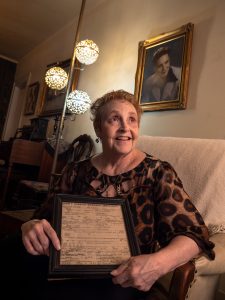 And she says she can help them do that. She was at her grandmother’s house every day after school, she says, so she recalls frequent interactions with “Mr. Lee.” He helped her with schoolwork and played with her brothers, she says. She remembers him as a kind young man.
And she says she can help them do that. She was at her grandmother’s house every day after school, she says, so she recalls frequent interactions with “Mr. Lee.” He helped her with schoolwork and played with her brothers, she says. She remembers him as a kind young man.
She says her interest in the JFK case has intensified with each passing year. Her beliefs line up closely with those of moviemaker Oliver Stone, who filmed scenes inside her house for his 1991 thriller JFK and who has been outspoken about his beliefs that Oswald was part of a larger conspiracy to kill Kennedy. Hall says she believes Oswald has been unfairly vilified by the U.S. government.
Whether one agrees with Hall’s theories or not, she offers intriguing conversation. For example, she talks about her mother, a photographer who had a studio near Texas Theatre.
“She saw the commotion across the street and saw Oswald — who she knew as her mother’s tenant, who played with her kids — being carried off by police. That’s when she came and pulled my brothers and I out of school,” Hall says. “See, this family’s fingerprints are all over that day.”
Whether or not the Oswald museum remains depends upon the willingness of someone to take it over eventually, says Hall, who is almost 70. She has two sons but says neither live in Dallas. One of her sons has said definitively that he does not want the house.
“And I am not going to saddle anyone with this who does not have a passion for it,” she says.
Without being specific, she says she has friends and other parties who have expressed interest in taking over.
The fact remains that due to the mortal constraints on every human, time left to hear Pat Hall’s story is limited.
“I love how invested young people are in the history, and I love talking to them,” Hall says. “For as long as I can be, I am here to put a human face on a man I knew as a little girl.”

